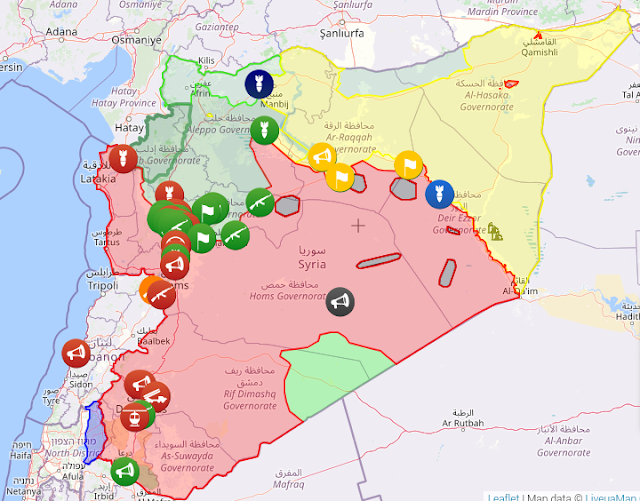Analysis: Will Hay’at Tahrir al-Sham (HTS) Reach Damascus? What Are the Supporting Factors, and Can the Regime Build an Alliance to Prevent Their Advance?
Military control map in Syria 06.12.2024
1. The Possibility of HTS Reaching Damascus:
A. The Military Situation:
HTS Combat Capabilities: HTS has a strong organizational structure in northern Syria, particularly in Idlib and its countryside, with well-trained units and relatively modern equipment. However, there are questions about whether they have sufficient logistics and manpower to launch a large-scale offensive toward Damascus.
Military Geography: The route to Damascus passes through complex geographical and military zones. The regime controls most of the territory surrounding the capital. HTS would need to break through well-fortified defensive lines, especially in areas like Hama, Homs, and the Damascus countryside.
Air Superiority of Russia and the Regime: The regime heavily relies on air superiority, supported by Russia, making any HTS ground advance highly vulnerable to intensive airstrikes.
B. Local Popular Support:
Presence of Sleeper Cells: HTS’s success in reaching Damascus would also depend on sleeper cells or local support in the areas it passes through. However, the areas around Damascus are under tight regime control and unlikely to harbor strong HTS support.
Sectarian Dynamics: Damascus and its surroundings are mixed sectarian areas, making it difficult for HTS, with its Sunni hardline ideology, to gain local support.
C. International and Regional Support:
Restricted External Aid: HTS faces international sanctions and isolation, making it difficult to secure external support.
Turkey's Position: While Turkey has cooperated with HTS on some issues, it is unlikely to back a major offensive toward Damascus, as this could undermine its strategic interests in Syria.
2. Supporting Factors for HTS to Reach Damascus:
A. Weaknesses of the Syrian Regime:
Military Exhaustion: The regime’s forces are fatigued after over a decade of war, suffering from a shortage of manpower and resources.
Economic Crises: The catastrophic economic situation in regime-held areas weakens its internal cohesion and increases the potential for internal disturbances that could distract it from countering HTS.
B. Fragmentation Among the Regime's Allies:
Tensions Between Russia and Iran: Despite both supporting the regime, their divergent strategic goals could lead to poor coordination in confronting HTS.
Divergences Among Local Forces: The regime relies on multiple militias with varying loyalties, which could undermine a unified defense against an HTS offensive.
C. Regional and Global Disruptions:
Reduced International Focus on Syria: With global attention diverted to crises like Ukraine or conflicts in East Asia, HTS might find an opportunity to expand amid a lack of decisive international intervention.
Potential Shifts in Turkey’s Stance: If Turkey’s interests shift due to deals with the opposition or Russia, the balance of power could tilt in HTS’s favor.
3. The Regime’s Ability to Build an Alliance to Thwart HTS:
A. Regional Alliances:
Russia and Iran: The regime heavily relies on Russian and Iranian support. Russia provides air cover and political backing, while Iran supplies ground forces through its militias.
Arab Normalization: Recent efforts by Arab states to normalize relations with the Syrian regime could translate into financial or political support, bolstering the regime’s ability to counter HTS.
B. Role of Local and International Militias:
Hezbollah: Hezbollah plays a pivotal role in securing areas around Damascus and protecting vital supply lines for the regime.
Iranian Militias: Their deployment in southern and western Syria forms a strong defensive buffer against potential HTS advances.
C. International Support:
The Role of the UN and Global Powers: The regime leverages fears of terrorism to gain international sympathy, potentially leading to foreign interventions supporting its efforts against HTS.
Conclusion:
HTS faces significant challenges in attempting to reach Damascus, including the regime and its allies’ air superiority, the lack of local support in areas surrounding the capital, and the strength of regional alliances backing the regime. On the other hand, HTS's success would require a major internal collapse within the regime or substantial regional and international shifts in its favor.
For now, the most likely scenario is a continued stalemate, with localized skirmishes and escalations by HTS without achieving any strategic breakthroughs.
- Geostrategic Studies Team / "Future Foresight" Department








